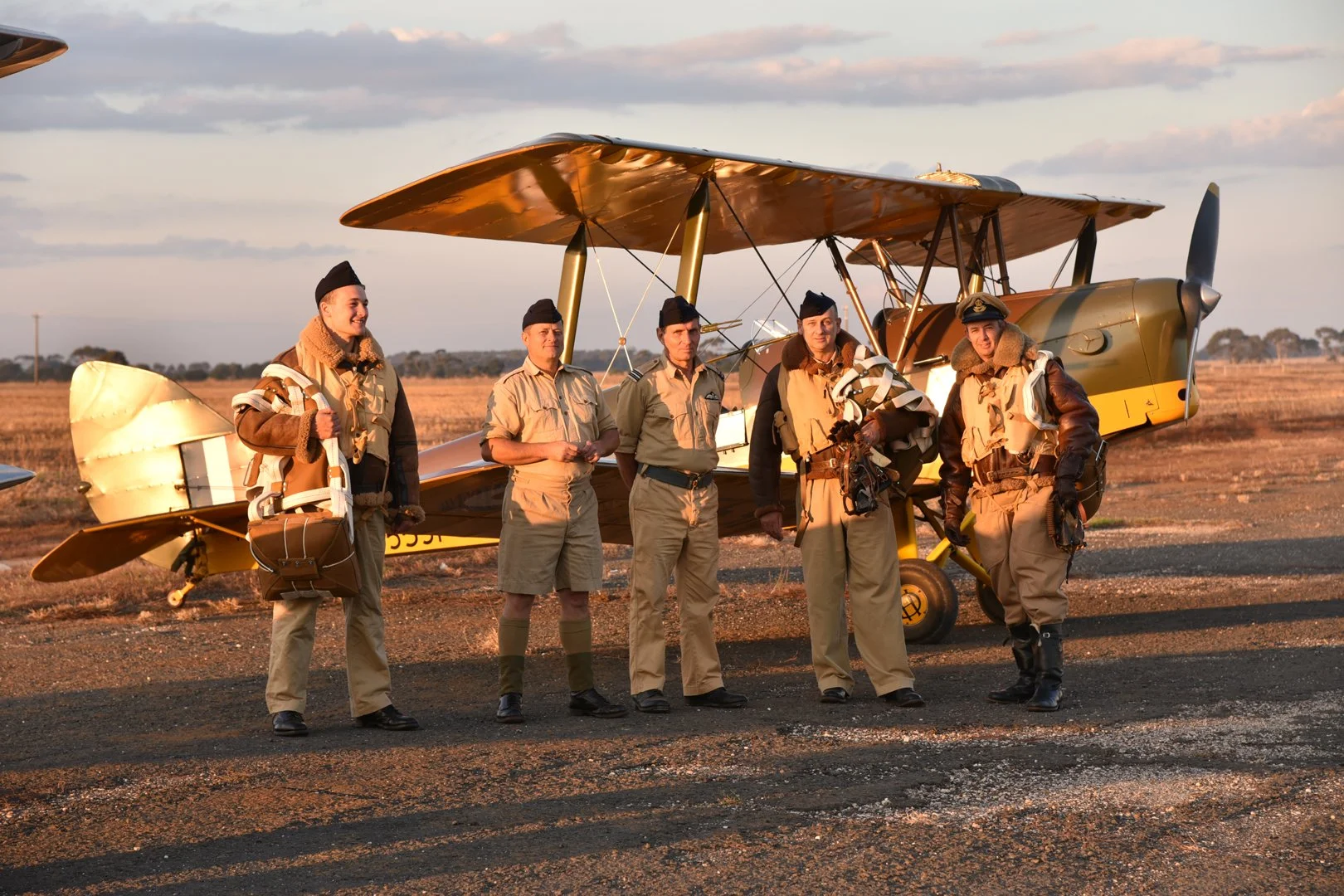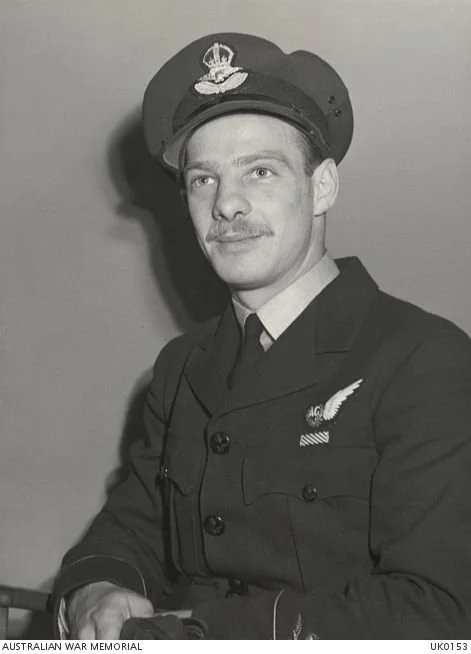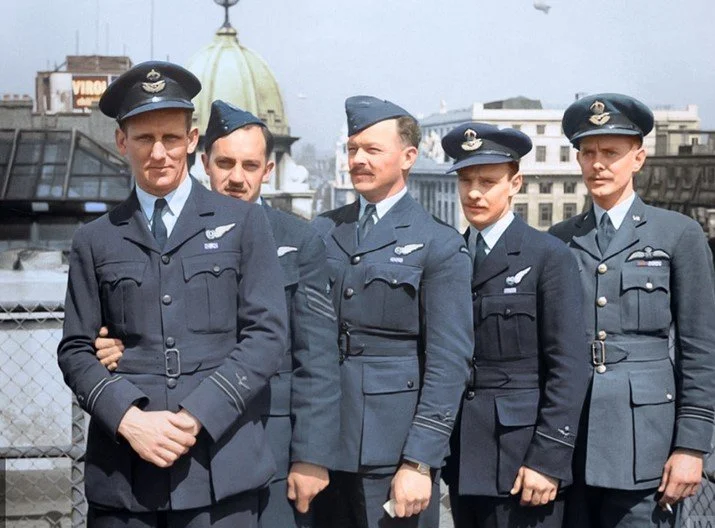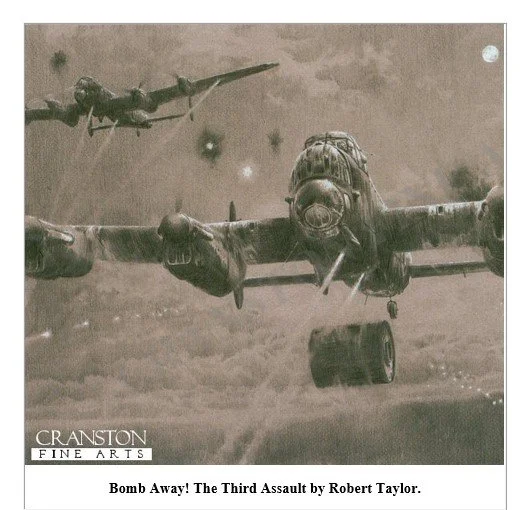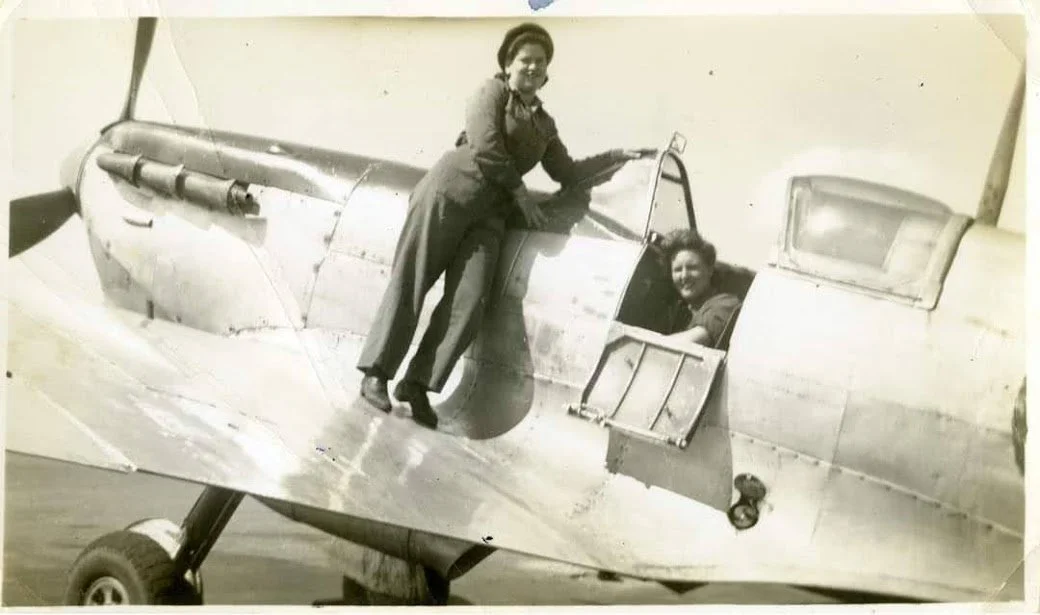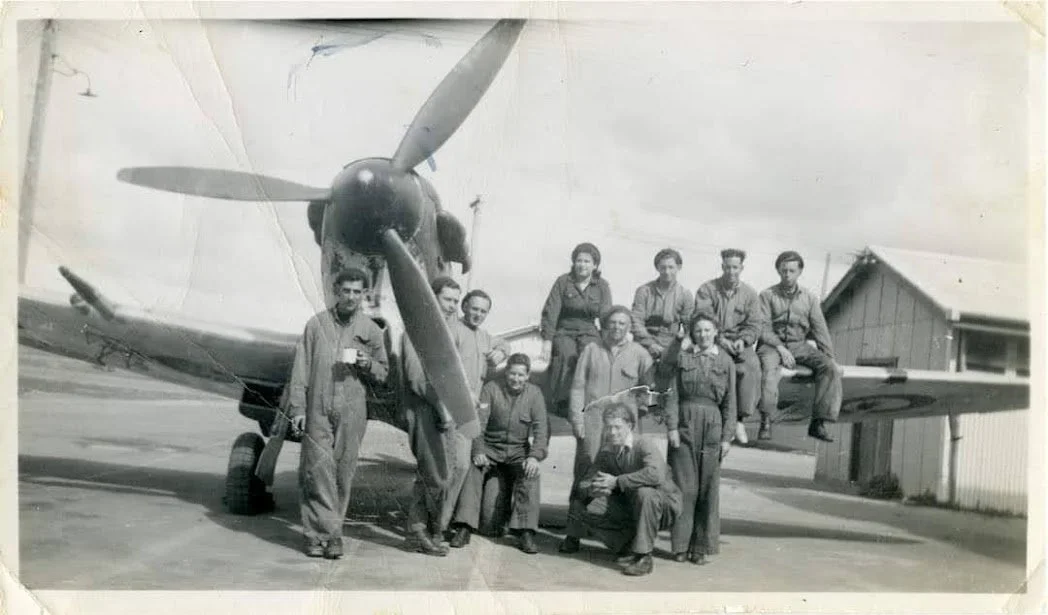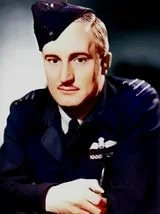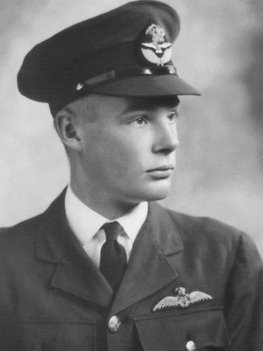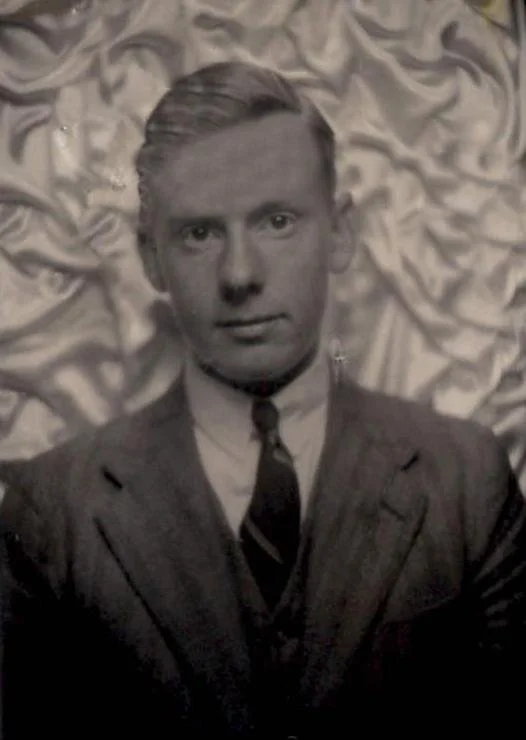History of Cressy Aerodrome
Cressy Airfield became operational in July 1939 when the Armament Training Squadron moved there. Later in 1942 the General Reconnaissance School from Point Cook moved to Cressy Airfield.
The main reason for establishing a major training base so close to Melbourne was that both Laverton and Point Cook were fully occupied with the assembly of aircraft.
The training role of this base went through a few changes during the war. From the Number 1 Armament Training School, to General Reconnaissance School and then it was the Central Gunnery School.
So, what could you expect to learn while at the RAAF base at Cressy, well, quite a bit it seems!
For example, if you were training to become an Observer/Navigator in 1943, your subjects would be Patrol and Search, Instruments, Maps and Charts reading, Magnet and Compass, Meteorology, Signals, Reconnaissance, Ship recognition, Photography and some more. All theory was done in the Lecture hall and practical would have been done, at the time, in either the Wirraways or Avro Ansons.
A course like this would last about eight weeks and if you passed, you would be sent onto another unit for the next level of training. Other subjects relating to the 1st Armament and Central Gunnery school would have been more tailored to the trainees attending these courses at the base.
Cressy’s Dambuster connection
Bertie Towner Foxlee
Foxlee fourth on from the left
Möhne Dam, Germany, May 17th, 0038 am, 1943.
Mick Martin, at the controls of his Lancaster Bomber were now traveling at the attack speed of 230 miles per hour, at 60 feet above the waters of the Mohne Dam.
Anti-aircraft and machine gun fire erupt from positions on and near the dam wall, firing at his aircraft. Guy Gibson was flying to Martins right, with all his lights on, trying to draw the fire from the German gunners, in order to help with Martin’s Bombing run.
The front gunner of Martin’s aircraft returned fire, the navigator continues to call to Martin, getting the bomber into its correct position.
Down , down, doooown, hooold, then the bomb aimer chips in, left, left, steady, hoooold,, hoooold, steady, Bomb away.
Now the engines of the big Lancaster start to roar as the power is applied for a speedy get-away. Moments after clearing the Dam wall, huge column of water rises up into the air at the wall of the Dam.
This is a very brief description of Mick Martin, his crew, and their Lancaster, that made the attack on the Mohne Dam on the 16-17th of May 1943.
This crew formed part of a very special Squadron, 617 Squadron, or as it is better known “The Dambusters” and this particular mission was code named “Chastise”.
There have been many books and documentary’s written and made about the Dambusters, even a movie that was made back in the 50s, an incredible story that deserves all of these.
You might be asking, what has this got to do with Cressy? Well one of the men who was on-board Mick Martin’s aircraft that night, ended up being a “Gunnery Instructor” at RAAF Station Cressy in 1945, and his name is Bertie Foxlee, DCF.
Bertie Towner Foxlee (better known as Toby) was born in Queensland on the 8th of March 1920 to Herbert and Olive Foxlee.
Foxlee attended Brisbane Grammer and Blenner-Hassetts Institute of Accounting.
He worked as a clerk for three years and a mechanic for one year, he also worked as an Accountant from 1937 to 1939. Foxlee also served in a Machine gun company (9/49 Battalion) before the war.
He enlisted on the 11th of October 1940 in Brisbane, at the age of 20 years and 7 months old. Bertie stood at 5ft,6 tall had a fair complexion, blue eyes, single and gave his religion as Church of England. At that time, he was living at 30 Fraser Street, Ashgrove, Brisbane.
On the 14 of October 1940 Bertie was sent to No. 2 Initial Training School, which was a part of the Empire Air Training Scheme. New recruits were posted to an Initial Training School to learn the basics of military life. They were taught subjects such as mathematics, navigation and aerodynamics, for Bertie it was training as a Wireless Operator / Air Gunner. After further training, on arrival in England, he was posted to 455 (Australian) Squadron at Swinderby, where he joined up with Mick Martin and Jack Leggo. After 14 missions Martin and his crew transferred to 50 Squadron, Foxlee went on to complete a tour of 34 operations by 13th September, and was transferred to a training unit. He was awarded the DFC for him work on his first tour and was commissioned. In Early April 1943, he joined up with Mick Martin, Jack Leggo and Tammy Simpson again, in the new 617 Squadron, practicing for the raids on the Dams. After the raid he carried on flying all his operations with Mick Martin. On the 13th February 1944, Foxlee was taken off operations after the Antheor Viaduct trip. He was awarded the DFC in April 1944, he and other crew members went to London to receive the award. Foxlee then returned to Australia and spent the rest of the war instructing at various units in across the country.
Foxlee arrived at RAAF Station Cressy on the 18th of January 1945, where he was the Gunnery Instructor. His time here was short for he was again transferred on the 8th of March 1945. His last posting was at Rathmines where he was demobbed on the 25th of June 1948.
He left the RAAF, returning to Britain to join the RAF, where he worked as an air traffic controller. Then married Thelma Madge Peacock in 1948 and they had five children. Foxlee finally retired from the RAF in 1957, and after farming for a while in Kent, took the whole family to live in Australia in 1962. He went back to Britain once more in 1977, and died in Nottingham on the 6th of March 1985, aged 65.
During WW2 the women of Australia would play and integral part in the Defence of our country. Thousands would enlist into the Navy, Army and Airforce and took over the roles of the men, whom enlisted into the Armed Forces.
Today’s story is about one of these women whom spent some time at RAAF Station Cressy, and her name is
SELMA MOTT
Born in Carlton, Victoria, on the 15th of June 1926.
Selma, also known as Sally, was the youngest of 8 children.
(Two of her brothers would go on to enlist. Edwin, went into the RAAF and Raymond, joined the Army.)
She attended the Burnley State School and then onto Richmond Domestic Arts School.
Selma had been working for J W Handley in Brunswick, Melbourne, as an Instrument Assembler for just over 3 years, before she enlisted into the RAAF on the 21st of March 1944 at No 1 Recruiting Centre.
On enlistment, Selma was 18 years and 2 months old, single, stood 5 ft and 2 inches tall, had blue eyes and dark brown hair and gave her religion as Church of England.
From No 1 Recruiting Centre, it was onto No 1 WAAAF training depot on the 21st of August 1944.
No.1 WAAAF Training Depot was formed at Mayfield Avenue, Malvern, Victoria on 6th of May 1941. It relocated to Geelong Grammar School at Corio, Victoria on 1st of January 1942. It then returned to Malvern on 31th of January 1942.
No. 1 WAAAF Training Depot then transferred to St. Catherine's School, Toorak, Victoria, on the 24th of March 1942 to allow extra accommodation room for more trainees. It then relocated to Preston, Victoria on the 22nd of January 1943.
On the 6th of October 1944, after her initial training, Selma was off to No 1 Engineering School
No. 1 Engineering School was formed on 1st of March 1940, at the Melbourne showgrounds at Ascot Vale and later overflowed into Flemington racecourse. The school grew quickly and by December of that year.
205 courses had commenced, with 2,600 trainees and 700 airmen and airwomen and 40 officers on staff. Courses also included those for cooks, drivers and intelligence officers.
There were an increasing number of airwomen under training, especially as wireless telegraphists. This resulted in female officers being posted in during March and by September there were 500 airwomen under training. By August 1942, 20,000 trainees had graduated, and in December 270 WAAAF telegraphists took part in a passing out parade. New courses commenced in 1943 included electrician instruments, instrument maker and fabric worker, reflecting the difficulty of recruiting personnel in specialist trades. Training for naval personnel on Allison c11 Engines commenced, as well as for WAAAFs as trainee flight mechanics. During 1943 over 12,000 tradesmen and women completed courses. The first WAAAF flight mechanics graduated in April 1943 and two more courses commenced, a pattern which continued all year. By November 1944, 50,000 trainees had graduated from the school. This heavy workload continued into 1945, and as fewer suitable candidates enlisted, some courses had high failure rates, not helped by a shortage of textbooks.
Once Selma completed her course it was now of to her next posting, on the 27th of April 1945 she arrived at the Central Gunnery School, at RAAF Station Cressy.
For the next 7 months she would toil away working on a number of different aircraft, as a Flight Rigger.
Her role was to help maintain the aircraft used at the base. Making sure that they were in operational condition so the air crews could perform their important training roles for the many crews that attended the school.
On the 24th of October 1945 Selma moved to her next posting, No 7 Aircraft Depot at Tocumwal.
This base was to play a very important role during the war as a maintenance facility for many types of Aircraft that were used by the RAAF at the time. The engines from the various aircraft would be rebuilt, tested and fitted back into aircraft. A propeller section and wireless maintenance shop were also established at the base, adding to its vital role to meet the demands of operating aircraft during this time of high wartime activity.
With the Japanese now pushed back and suffering many defeats, the wartime work load for many people here in Australia was slowing down, and many were being discharged from service. For Selma, she was discharged on the 5th of February 1946, and would return back to civilian life.
Selma married Walter James Dawes, known as Wally, on the 14th of February 1948.
Walter had served as a Gunner in the Australian Army and saw service in New Guinea.
Sally and Wally had eight children,
Pamela, Kenneth, Brian, Ross, Eric, Marilyn, Neil and Sandra
Selma passed away on the 25th of August 2006 at the age of 80 and was laid to rest at Springvale Cemetery in Melbourne.
Researching people who served at Cressy has been a rewarding endevour, and it is also exciting when you find someone who can help fill in the gaps of someone who served at this RAAF Station. I would like to personally thank Sandra, whom is the daughter to Selma, for your contribution, I have enjoyed our chats on the phone and email exchanges.
Also, to Matt, from the Tocumwal Aviation Museum, for putting us in touch with Sandra.
It’s great to have a network of “like minded” people helping grow and share the stories of our service men and women whom helped defend this great country.Take a minute to write an introduction that is short, sweet, and to the point.
Grahme Patrick LOBWEIN AFC
Graham Patrick Lobwein was born on the 24th September 1920 in Toowoomba QLD, the eldest son of Francis and Catherine Lobwein. He had a younger brother and the family lived at Wilsonton, a suburb of Toowoomba. His secondary schooling took place at Downlands College, a Catholic boarding school for boys in Toowoomba. He attained his Junior Certificate and left school to work as a radio assistant at McKinney Radio and Electrical Company in Toowoomba. His interests included motor cycle racing, golf and stamp collecting.
At age 18 he joined the Australian Army serving with the 11th Light Horse Regiment, a part-time unit based in the Darling Downs region of Queensland. His service number was 76248 and he attained the rank of Corporal in the 18 months of service with this regiment.
He discharged from the Army to join the RAAF Reserve on the 6th June 1940. Five months later, on the 8th November, he enlisted in the RAAF aged 20. His service number was 404723, his rank an Aircraftman 2. In his service record he’s described as being 5ft 7ins tall, with a dark complexion, black hair and blue eyes.
Grahme commenced his training at No. 2 Initial Training School at Bradfield Park NSW and in early January 1941 was promoted to Leading Aircraftman. A few days later he proceeded to No. 6 Elementary Flying Training School at Tamworth NSW. Two months later he proceeded to No. 3 Service Flying Training School at Amberley QLD where he took part in No. 8 flight training course. Three months later he graduated as a Sergeant Pilot. In July 1941 Grahme proceeded to No. 2 Communication Unit at Mascot NSW and then attended the Central Flight School at Camden where he undertook a flying instructor’s course for 3 months. He then proceeded to No. 3 SFTS at Amberley and in November was graded as a Flight Instructor “C”. In early 1942 he was regraded to a Flight Instructor “B”.
In April 1942 Grahme was promoted to Flight Sergeant and posted to No. 1 SFTS at Point Cook, then spent 2 months at the General Reconnaissance School at Cressy VIC, where he undertook a navigation reconnaissance course in becoming a master navigator. These men were usually posted to maritime patrol duties. He passed with a special distinction. He was promoted to Pilot Officer and proceeded to No. 1 Air Observers School at Cootamundra NSW. A month later he was posted to 107 Squadron which was a Seaplane Training Squadron. He then proceeded to No 3 Operational Training Unit at Rathmines NSW which was the main seaplane training unit for the RAAF during WW2.
In early March 1943 Grahme was posted to No. 6 Communication Unit, based at Batchelor airfield in the Northern Territory, which performed Air-Sea Rescue Operations. ( In late 1945 the unit moved from Batchelor to Parap airfield in Darwin).
In April 1943 he was promoted to Flying Officer and a year later he completed his tour having rescued 23 RAAF and Allied airmen. He was promoted to Flight Lieutenant on the 1st October 1944 and 12 days later was awarded the Air Force Cross, becoming Australia’s 24th recipient. The AFC is a military decoration awarded to officers, and since 1993 other ranks, of the United Kingdom Armed Forces, and formerly also to officers of the other Commonwealth countries. It is granted for "an act or acts of exemplary gallantry while flying, though not in active operations against the enemy “.
From the end of January to the beginning of April 1945 Grahme was admitted to hospital twice but the nature of his condition on both occasions were not recorded. In early May he proceeded to Archerfield airfield in Queensland and then to No. 3 Embarkation Depot at Sandgate. Three months later he was posted to the 107 Squadron at St George Basin south of Sydney NSW. In October, while serving with the 107 Squadron, Grahme had to make a forced landing at Rose Bay airfield NSW. He remained with this Squadron until being attached to the RAAF Headquarters in Brisbane for all of March and April 1945.
Grahme took 3 weeks leave from the 6th to the 26th July 1945 for two very special reasons. The first one was on the 14th July when he married Joyce (Joy) Eden at Ashfield NSW. The second was on the 23rd July when he was presented the Air Force Cross by the Duke of Gloucester at Admiralty House, the residence of Australia’s Governor-General. Remarks in service record by the 107 Squadron Leader show the calibre of the man that Grahme was…“A rare and conscientious officer who is a good mixer. Service minded and takes an active interest in station affairs, particularly airmen’s welfare. He carries out his aircrew duties in an efficient manner and is popular with fellow officers.”
In October Grahme was posted to the 33 Squadron based in Lae New Guinea. Following the end of hostilities in August this squadron was tasked with repatriating service personnel and former prisoners of war. On November 15th a Dakota plane left Lae for a routine flight to Rabaul, stopping at Finschafen and Jacquinot Bay airfields along the way. There were 28 aboard the flight…pilot Ron Hanrahan, co-pilot Grahme Lobwein, navigator Douglas Bruderlin, nurse Sister Verdun Sheah, 14 personnel from the Australian Army, Navy and RAAF, one of them a stowaway, as well as 10 Indian POW’s. The Indians were all members of the 2/12th Frontier Force Regiment who had surrendered at Singapore. In October they’d been liberated by the Australian Army and were the only survivors of their contingent. They were on their way to Rabaul to give evidence at the war trials. The plane left Jacquinot Bay at 9am for the 50min flight to Rabaul. A radio call was received from them 14 mins after take off but when the flight failed to arrive at Rabaul it was declared as missing in action. A search was mounted and at 4pm the following day the crash site was located by the 33 Squadron Leader. The plane had crashed into an unnamed mountain at an elevation of 7,000ft and roughly 150ft below the peak in the area known as Milim approximately 6 miles inland from Wide Bay. All aboard were killed instantly. The wreckage was strewn across a large area. A portion of the wing was sighted hanging in a tree and the tops of the trees were knocked off at a height of 10ft. Wreckage under the trees showed complete disintegration but the aircraft didn’t burn. It was apparent by the wreckage distribution that both pilots had tried desperately to pull the nose of the plane up and over the peak but the steepness of the terrain had beaten them.
The following day another aircraft from the 33 Squadron flew over the crash site and dipped its wings in salute to the 28 below. It dropped 2 wreaths, one for the crew from the men of 33 Squadron and one for Sister Sheah from the nursing sisters of her unit, No. 1 Medical Air Evacuation Transport Unit. These nurses had a special function in that they were all trained sisters but also undertook a specialised aviation course to gain their “wings.” The RAAF created their flying nurses to accompany flights with wounded soldiers or POWs. That day Sister Sheah stood in for another nurse who was rostered for the flight but reported sick. It was also later revealed that Sister Sheah had had a premonition of her death.
The search party sent to recover the remains of the crew and passengers determined that the Dakota had flown into a cloud and slammed into the mountain. It was also later determined that the height of the mountain had been incorrectly plotted on maps. On wartime maps the mountain was listed as being 7,000ft whereas on modern maps it’s listed as being 7,598ft high. It appears that the 2 pilots thought they would clear the mountain by some 500ft when in fact they were 98ft short and flew straight into the mountain just 150ft from the top. The remains of all aboard were recovered, transported to Rabaul and buried individually at the Rabaul War Cemetery.
During his years of serving in the RAAF Grahme was qualified to fly a number of aircraft including the Tiger Moth, Moth Minor, Gipsy Moth, Wackett Trainer, Avro Trainer, Avro Anson, Kingfisher, Airspeed Oxford, Hudson, DC3, Dragon DH 84, Sikorsky and the Walrus Seagull.
Grahme’s life was cut tragically short at the age of 25 and just 3 months after marrying his sweetheart Joy. However, some months after the crash there was a sweet reminder of Grahme for Joy when she gave birth to their daughter in April 1946.
Grahme’s name appears on two war memorials…one at Hurstville NSW and the other at Acland in Toowoomba QLD.
Grahme Patrick Lobwein was awarded for service in WW2 the Australia Service Medal, Australia Defence Medal, 1939-1945 Star and the Air Force Cross.
Information researched by Sue Smith and David Barlow
1941 Cressy RAAF
Football team
With Footy season well under way, what will the rest of the season have installed for us.
Will it be “Back-to-Back” for the Mighty Pies, or will there be a number of surprises throughout the remaining part of the season, we will see.
No matter what is happening in the world, sport has always played its part in helping get our minds off those pressing issues, even if it's for a short time.
Even during a time of War, there was time for sport.
During WW2, the men stationed at the Cressy RAAF base had a Football team.
It was made up of pilots and ground crew alike, and they competed in the local league.
We don’t have any information at this time on how they went, but we are very fortunate that a photo has come to light of the 1941 Cressy RAAF team.
We are also very fortunate that the names of many of the men who were a part of this team, have their names written on the back of the photo, and that the colour of the jumper, was Blue and White.
We have managed to research just under half of these men, and will be posting their stories in due time.
KEITH RAYMOND JOHN PARSONS
CBE - Commander of the British Empire. DSO - Distinguished Service Order
DFC - Distinguished Flight Cross. AFC - Air Force Cross
KEITH Parsons was given the honour of a full military funeral after a highly-decorated career which included time as Commanding Officer of Number 460 (Lancaster) Squadron.
Keith was born on the 28th of June 1914 in Scottsdale, Tasmania and joined the Royal Australian Air Force in January 1935, as an air cadet, learning to fly in a Tiger Moth aircraft at RAAF Point Cook.
As a Flight Lieutenant in late 1939, he became the chief flying instructor at the No. 1 Elementary Flying Training School at Parafield, teaching pilots to fly in Tiger Moth and Liberator aircraft.
It wasn't long after that he was promoted to Squadron Leader, and posted as the Commanding Officer of No. 1 Armament Training Station at Cressy in Victoria, from the 27th of March 1941 to the 27th of April 1942, this was to be the first of many commands.
It was as the Commanding Officer of No. 7 Squadron that Keith, was promoted to Wing Commander, it saw his first combat service. He flew many combat missions in the South-West Pacific Arena and received the Distinguished Flying Cross for his courage, hard work and devotion to duty.
In 1944, Keith was posted to Bomber Command in the UK and flew combat missions in the European theatre, including as the Commanding Officer of the famous 460 Squadron.
Keith was promoted to Group Captain and given command of RAF Station Bimbrook, a large bomber base, where 460 Squadron was based. He occasionally broke the rules and went on operations himself. One such illegal operation over Germany was nearly his last and the one for which he was awarded the Distinguished Service Order.
He recalled flying at around 19,000ft with no navigation light on - as they always flew in complete darkness - "when suddenly a Lancaster appeared out of the dark heading at an angle straight for us.
"I shoved the stick hard forward and this bloke wiped right across the top of us, smashing the (cockpit) canopy on the top and then collected my two port engines."
The aircraft became unmanageable and went into a tight spin. Although he didn't have time to bail out the normal way, Keith told his crew to jump and then managed to get through the shattered canopy.
His chute had been ripped from the bottom up to the apex and opened hard. Under normal circumstances, the chute would have opened but with the tear, as soon as it started to fill with air it collapsed straight away.
After the war, Keith returned to Australia. His knowledge and experience counted in his being made Air Attache in Washington in 1951.
Later, he was Base Commander of RAAF Point Cook and then Commanding Officer of the RAAF Base Butterworth in Malaysia in 1958. He was promoted to Air Commodore in 1961. He retired in 1969.
Air Commodore Parsons' honours and awards included Commander of the most excellent Order of the British Empire (CBE); Distinguished Service Order (DSO); Distinguished Flying Cross (DFC) and the Air Force Cross (AFC).
He also was awarded the 1939-45 Star; Pacific Star; France & Germany Star; War Medal 1939-45; Australia Service Medal 1939-45; General Service Medal (Malaya Clasp); Coronation Medal; and Returned from Active Service Badge.
Keith Parsons passed away on the 27th of June 2011in Adelaide, leaving behind his children Kay and Vicki and six grandchildren.
ERIC ANTONY GOGLER
Born on the 25th of April 1921, to Amos and Siliva Gogler of Port Augusta, South Australia.
Eric was one of four boys in the family, Colin, Rex and Ivan.
Rex would enlist into the RAAF and on discharge in 1945, he held the rank of Fight Lieutenant.
Eric working as a Bank Officer when he enlisted into the RAAF on the 11th of October 1941, at No5 Recruiting Centre RAAF, Adelaide, South Australia.
He was 20 years old and stood 5ft 7inch tall. Eric had a “Fair complexion”, Blue eyes and Light Brown hair and was living at number 17 Seafield Avenue in Kingswood, South Australia.
Eric trained at No 4 Initial Training School (11 Oct 1941) No 1 Elementary Flight Training School (5th of February 1942) and Service Flying Training School at Mallala (6th April 1942) before he arrived at the General Reconnaissance School, at Cressy.
He was at Cressy from the 9th of October 1942, until the 29th of December 1942.
From Cressy, he went to 1 Operational Training Unit (O.T.U) at East Sale, Victoria.
It was here that Eric witnessed how dangerous training was. While conducting a night time training mission, tragedy struck.
Beaufort aircraft A9-166, operated by Eric and his crew, took off in formation from No.1 Operational Training Unit, East Sale, at approximately 1830 hours on 28th April 1943, to carry out training night bombing exercise. The duration of the exercise was 4.5 hours. The flight was duly authorised, the crews briefed in all aspects of the exercise and aircraft was fully serviceable at the commencement of the flight. Airman – Offer, Catterick, Nichols & Waterman were detailed for duty as the crew of A9-304. The exercise was carried out satisfactory and on the return journey bad weather was encountered between Flinders Island and King Island. The aircraft were at a height of 2000 – 3000 feet and the pilot of A9-166 instructed A9-304 to reduce height. At approximately 2105 hours, when the aircraft were about 5 miles from King Island, at a height of 800 feet, the leader decided to turn back on account of the weather. He advised A9-304 that he was turning to port which he amended almost immediately to turning to starboard. The pilot of A9-304 commenced a turn to port and on the amended order he took evasive action in a diving turn to starboard. At the reduced height and in poor visibility the pilot of A9-304 apparently misjudged the correct moment for the recovery of the turn with the result that the aircraft dived into the water while still banked.
Searches by land parties, aircraft and naval vessels for this crew and aircraft were unsuccessful.
A stint with No 7 Squadron would then see Eric posted in the New Guinea area, from the 27th of May 1943 to the 25th of April 1945.
It’s here Eric would join 100 Squadron on the 26th of April 1945, and would stay with them until the 11th of November 1945, and he would also be in temporary Command of 100 Squadron from the 18th of September 1945.
On the 27th of June 1946, Eric was discharged from the RAAF. During his time in the RAAF, he would complete 33 hours flying the Tiger Moths, 102 hours flying Avro Ansons and 932 hours with the Beaufort Bombers. Held the rank of Pilot Officer on the17th of September 1942, Flying Officer 17th of March 1943 and Flight Lieutenant from the 17th of September 1944, which is the rank he held until discharged, and had completed a grand total 1298 flying hours.
Eric would get married, in 1950, to Josephine Valmai Gogler (Sweeney) at Rostrevor.
In 1954, he was working for the Shell Oil company as a clerk in Darwin, and Josephine was doing house duties.
Eric passed away on the 25th of June 1985, in Adelaide, South Australia, aged 64.
He was buried at Centennial Park Cemetery, Pasadena, Mitcham City, South Australia, plot H, path 27, Grave 1507.
Josephine Valmai Gogler (Sweeney), Eric’s wife, passed away on 25th of August 2022 in Daw Park, Mitchem South Australia, leaving behind their children Peter, Kath. Kevin, Brian and Greg.
Edward John OFFER
Born in Subiaco, Western Australia on the 3rd of October 1919, to Francis John and Margaret Agnes Offer.
Edward had a younger brother, William Patrick Offer. William would also serve during WW2, as a private with 2/9 Transport platoon.
Edward started his schooling at the Armadale State school, WA, from July 1925 to December 1932 and then onto Perth Modern School from February 1933 to December 1935.
Sadly, in 1936, the Offer family mourned the passing of Margaret, wife to Francis, and mother to both Edward and William.
Edward continued studying, this would be at the University of Western Australia.
His study and grades would see him take up a job as a Junior Clerk in Government Service and then as an Audit Clerk with SJ McGibbons and Co.
On the 7th of December 1941, Edward enlisted into the RAAF at the age of 22, at Number 4 RAAF Recruiting Centre in Perth.
He had served with the Armed Forces in an Infantry Battalion, before taking the opportunity to join the RAAF.
Edwards enlistment papers mentioned that on he was single, stood 5ft 5inches tall, had hazel eyes and brown hair. He was living at number 7 St Albons Crescent, Highgate, and his next of Kin, was his father Francis, who was living at 96 Aberdeen Street, Perth.
Edwards first posting was to Number 5 Initial Training School (No 5 ITS) located at Clontaaf, Western Australia, on the 7th of December 1941.
His next postings will be to Cunderdin, home to No. 9 Elementary Flying Training School (No. 9 EFTS) on the 22-04-42. Then it was onto No. 6 Service Flying Training School (No. 6 SFTS) on the 29th May 1942. This school was responsible for intermediate and advanced instruction of pilots under the Empire Air Training Scheme (EATS), the school was based at RAAF Station Mallala, South Australia.
It was then onto No.1 Embarkation Depot (No1 ED) on the 1st of November 1942, located at the Melbourne Show grounds in Victoria and to the General Reconnaissance School at Cressy, where Edward was stationed for 8 weeks, from the 22nd of November 1942 to the 16th of January 1943.
The next posting was to No. 1 Operational Training Unit (1 OTU) on the 9th of February 1943, located at Bairnsdale in Victoria.
The courses involved some basic training and a six-week conversion to flying twin engine Hudson and Beaufort aircraft. While pilots became familiar with the aircraft, air observers and wireless operator/air gunners received their training in the Oxford and Anson aircraft. Due to the demands imposed by the Empire Air Training Scheme, No. 1 OTU worked virtually 24 hours a day. And sadly, this demand put a lot of pressure on Air and Ground crews, along with Aircraft. In fact, while operational, the unit had suffered 147 aircraft accidents in Southern Australia and New Guinea which left 131 aircrew dead or presumed missing, during the Unit's intense program of training exercises and operational missions.
No. 1 OTU was also tasked operational patrols to safeguard shipping lanes along our coastline.
One of these accidents happened during a training mission on the 28th of April 1943, in Bass Strait, near King Island.
Two Beaufort bombers were conducting a training mission when bad weather was encountered. They both started turning away from this, when, one of the Beaufort Bombers was seen to bank steeply and dive towards the sea from a height of 800 to 900 feet.
The Beaufort Bomber, A9-304, and her crew,
Navigator, Flight/Sgt James Henry Catterick
W/T Operator, Flight/Sgt Edward Waterman,
Wireless, Air Gunner (W.A.G) Flight/Sgt Graham Charlies Nichols,
and Pilot, Sgt Edward John Offer, crashed into the sea.
At first, they were reported as missing, but later classed as having, died during a training mission.
This crew and aircraft are still missing today, but their names are commemorated on the” Roll of Honour” wall at the Australian War Memorial in Canberra.
De Havilland DH82A Tiger Moth
"MILLIE"
Today we wish to give you a bit of history relating to our much-loved Tiger Moth “Millie”.
Built at Hatfield in the United Kingdom, Tiger Moth T5531 arrived in Australia as a part of a batch of thirty-four Tiger Moths for the RAAF. These were delivered, pre-Pacific war, between July and September 1940.
When the war ended, T5531 was offered for disposal in 1946, at Western Junction, Tasmania and was sold for £180.
T5531 would spend most of her life in NSW with various owners, and a few years in between in Qld, before being purchased in April 2021 by Perlam Aviation Pty Ltd.
Affectionately known as “Millie” she now calls the old WW2 RAAF base located at Cressy in Victoria, home.
Millie’s arrival at Cressy has been very well received by many people. Scenic flights over the surrounding area have enabled many more people the opportunity to experience a flight in a Tiger Moth.
So far in her time at Cressy, she has done many scenic flights, competed in a Tiger Moth race, where she came 2nd and completed a Commemorative flight, which saw her fly from Cressy, over Bass Strait to Hobart and back again via Canberra.
We are so privileged to have such an aircraft at our historic RAAF base and we are sure “Millie” will continue to bring joy to many others in the future.
We had a chance encounter, at the 2023 Australian International Airshow, at Avalon, with a man by the name of Alan Flett. Alan has been taking photos of Aircraft for many years and he mentioned that he had photos of Millie.
Now, because of Alan, we have a small photographic record of Millie, in her early days.
We also had another photo passed onto us, of Millie at the Essendon airport in 1941, we must thank Dion from “Aviation Report” for his research in finding this particular photo, from the Civil Aviation Historical Society at Essendon Aerodrome and for taking the most up-to date photo of Millie.
Archibald Robert Tindal
Cressy was one of those bases that would see some very capable leaders during WW2.
One of these commanders enlisted into the RAAF at the age of 18 and would raise to the rank of Wing Commander, his name, Archibald Robert Tindal
Born on 18th of January 1916 at Fir Grove, Eversley in Hampshire, England, to Archibald Arthur and Hilda Dorothy Tindal
Tindal’s father, Archibald Arthur, had responded to newspaper advertisements for English Army Reservists living in New South Wales to join the Expeditionary Force to Europe.
The family undertook the journey to England; this would have been an anxious time for the young parents in those days of World War I with German U-boats patrolling the oceans.
Archibald’s father, is recorded as enlisting on 19th of October 1915, into the Royal Field Artillery with the rank of Second Lieutenant. He was sent to the Somme in France in March 1916, when his young son was only a little over two months old. Sadly, it was there, in the Battle of Guillemont, that he lost his life on 18 September 1916. Thus, his son, Archibald Robert Tindal, never knew his father.
After the end of World War I, and following the tragic death of her husband Archibald Arthur, Hilda Tindal brought the children home to be near family. Tindal’s grandfather, Charles Frederick, was by then living at Bona Vista, Armidale. The family settled at Hill Cottage, 133 Dangar Street, Armidale. Tindal was enrolled as a day student at The Armidale School, known as TAS. The school was the only Greater Public School outside Sydney in New South Wales and was known for its excellent educational facilities. Archibald was a junior in Tyrell House and later a House Captain and a Monitor during his years at TAS from 1925 to 1934. He was also a member of the School Cadet Corps.
It was only natural that young 'Archie', following on in the family tradition, would want to be in the Defence Services. On leaving school, he joined the Royal Australian Air Force on 16 July 1934 as an Air Cadet and then quickly rose through the ranks becoming Pilot Officer (1 July 1935), Flying Officer (1 July 1936), Flying Lieutenant (1 January 1938), Squadron Leader (1 June 1940) and finally Wing Commander (1 January 1942). During this time, he served with 3 Squadron, 24 Squadron, and HQ Northern Area, in addition to attending several different air force training schools.
One of these postings was to 1 Armament Training School at Cressy. Here he was the Commanding Officer in charge of an establishing RAAF Base. Archibald’s posting at Cressy was from 24th of July 1939 to the 8th of September 1940.
At that time there were some tents for accommodation and a hanger made of Canvas,and as for aircraft, they were mainly the Hawker Demon Biplanes.
By January 1942, Tindal was posted to HQ North Western Area, Darwin, as Area Armament Officer.
During the Japanese attack on Darwin, on the 19th of February 1942, Wing Commander Tindal manned a Lewis machine gun and opened up on the Zeros flying overhead. He continued the one-sided struggle for some time before he was finally killed by a shell from a strafing Zero.
Wing Commander Tindal’s grave is located at Grave Reference/Panel Number: C.A. 16
in the war cemetery at Adelaide River. He was twenty-six when killed and was possibly the first Air Force casualty on mainland Australia.
After World War II, an airfield south of Katherine, Carsons Field, was renamed Tindal Airfield after Wing Commander Tindal. Now called RAAF Base Tindal, it serves as a permanent reminder of Tindal’s heroic actions during the initial raid by the Japanese on Darwin on 19 February 1942.
Hawker Demon G P Fighter
Developed from the Hawker Hart bomber to address the Royal Air Force's lack of a fast fighter aircraft, the Demon went into production for the RAF in 1932, with a total of 304 aircraft eventually produced.
In August 1934 the Australian Government ordered 18 Hawker Demons for the RAAF. Powered by a Rolls Royce Kestrel Mk V engine, these aircraft were for use as general purpose/fighter aircraft. Subsequently a further 36 were purchased for army co-operation and fighter-bomber duties and another 10 for target towing and training duties, with the 64 Demons serving with Nos 1, 2, 3, 12 and 22 Squadrons and No 1 Communications Unit.
On the eve of World War II, the 54 Demons still in operational service were progressively replaced by CAC Wirraways, for use in the training and communications roles, and the last of the Demons were eventually phased out by the end of the war.
The Hawker Demons were allocated to Cressy from 1938.
One of the first incidents involving the Hawker Demons at Cressy happened on the 28th of February 1938, when Aircraft A1-15 taxied into A1-53, causing slight damage to the aircraft.
More incidents would follow with this type of aircraft at the Cressy Aerodrome, thankfully, no aircrew were badly hurt or killed.
Roy Dennis
Born on the 14th of May 1918 to his parents George and Ethel Dennis.
Roy was a clerk until he joined the RAAF on the 17th of January 1938, as an “Air cadet”.
After Twelve months of training at Point Cook, he was promoted to Pilot Officer on the 17th of December 1939, and then to Flying Officer 17th of June 1939.
Roy was then posted as the Commanding Officer to No1 Armament Training School (No1 ATS) on the 24th of July 1939.
On the 11th of March 1940, Roy was then posted to Point Cook, one of many more posting that would see him in many locations around Australia.
One of these postings was with No 13 Squadron, from 13th of June 1944 to the 2nd of March 1945, flying on operational sorties.
On the 1st of January 1945 Roy was now a Squadron leader and then on the 1st of October 1945 he was discharged from there RAAF.
In his time, he had flown a number of aircraft, from basic trainers, Hawker Demons, Wirraways, Hudson’s, Ventura’s and Avro Ansons. It is this aircraft the he would fly the most, clocking up 1128 flying hours. In total, Roy flew a total of 2224 hours.
It was on the 6th of March 1942, Roy married his “sweetheart” Ronah, and she would follow him for one posting to the next.
Roy passed away peacefully at home on the 25th of June 2004, a loved son of his late parents, George and Ethel Dennis and loving husband to Ronah (dec.) of 61 years. His passing left behind adoring Children and Grand-Children.

